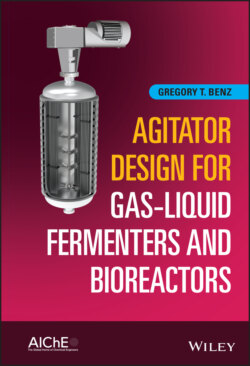Читать книгу Agitator Design for Gas-Liquid Fermenters and Bioreactors - Gregory T. Benz - Страница 10
Оглавление
Preface
This is a book about fluid agitation, as applied to gas–liquid systems such as fermenters or bioreactors (We will use those terms interchangeably in this text.). The specific focus is on mechanically agitated systems, consisting of a closed vessel with a rotating shaft and impellers, as this is the most common and versatile way to achieve process objectives in a gas–liquid system. Though airlift and bubble columns have also been used, they will not be discussed in any detail here, as that is not the focus of this book.
Many books have been written about fluid agitation. Many books have also been written about fermentation. Much, though not all, of the material in this book has been covered in such books. However, all such books cover much more than agitator design for bioreactors. For example, typical books on agitation cover topics such as solids suspension (almost never an issue in fermentation), highly viscous systems (>50 000 cP), specialized impellers such as helical ribbons, anchors, augers, and others that have no use in fermenters, mixing in high‐yield stress fluids such as paper stock, etc. Likewise, books on fermenter design usually cover some topics on agitator design but also cover feeding strategies, reaction kinetics, cell metabolism, sensitivity to concentration and temperature changes, product recovery, and a whole host of other topics. Little has been published in such books about how to acquire the proper pilot data for agitator design, or how to minimize energy consumption.
The main purpose of this book is to be a single‐source reference on all the major issues related to agitator design for bioreactors. It is intended to save the reader time by avoiding the need to consult multiple references or sift through many pages of text to find what is needed specifically for fermenter agitator design. This book will also cover important related topics such as heat transfer, power cost, basic agitator mechanical design, and vendor bid evaluation.
Though some introductory fundamental theory is included, the main focus is on practical application of theory to real‐world agitator design. This book is more of a how‐to book than an academic treatise. The relative brevity of the book is intentional. It is hoped that the brevity will encourage people to actually read the entire book, not just skim an occasional page or chapter.
This book is intended to be useful for a variety of people. Since it is primarily a technical document, most readers will have a science or engineering degree. Many will be Chemical Engineers. Some will be chemists or microbiologists tasked with operating facilities in a way that can produce scalable data. Academic degrees among readers will vary from Bachelor up through Post‐Doc. Most readers will be employed by companies using bioprocessing to make valuable products as well as many making commodity products. Some will work for agitator manufacturers. If used as a course supplement, some will be college students or professors. Top‐level managers may want to skim the contents to make sure their teams are properly staffed and have a high‐level view of what their team should be doing. They will find the overview and flow chart described in Chapter 2 especially useful. Chapters on energy use optimization will also be of interest to business unit managers. Information on bid evaluation should be of interest to procurement professionals. Although written primarily for users of agitation equipment and operators of fermentation facilities, engineers employed by agitator manufacturers will likely find it of interest as it provides a deeper window into the details of these applications than they are accustomed to, as well as how their bids may be viewed in a competitive environment.
A note about symbols: rather than make the reader refer to a list of symbols in the appendix, each chapter has the symbols used in that chapter at the end. That should save the reader some time. Also, it lets the author use the same symbol for different purposes in different contexts, reducing the number of symbols needed. For example, C means off bottom impeller clearance in most cases, but in the context of mass transfer correlations, it is used as an exponent, and it can also mean dissolved gas concentration.
Most of the book is focused on gas–liquid agitation, as that is the controlling parameter for most bioreactors. By that I mean the agitator is primarily designed to disperse gasses into liquids. This does not mean evolving gas from solution, which is a separate case. The fundamentals presented are applicable to other processes as well, such as miscible liquid blending, but design procedures for these problem categories are not presented here.
Gregory T. BenzBenz Technology International, Inc.
